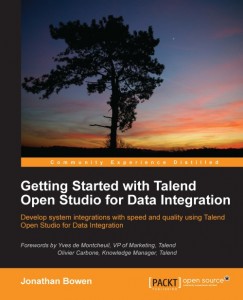Learn Talend's Open Source Big Data Platform from a Book
If the number of books published about an open source technology are any measure of its success, Talend has reason to celebrate.

 If the number of books published about an open source technology are any measure of its success, Talend has reason to celebrate. Getting Started with Talend Open Studio for Data Integration, the first comprehensive guide to Talend’s popular Big Data platform produced by a third party, has just hit the market. And it’s likely to appeal not only to IT personnel working with Talend directly, but also to anyone interested in the evolution of the Big Data channel.
If the number of books published about an open source technology are any measure of its success, Talend has reason to celebrate. Getting Started with Talend Open Studio for Data Integration, the first comprehensive guide to Talend’s popular Big Data platform produced by a third party, has just hit the market. And it’s likely to appeal not only to IT personnel working with Talend directly, but also to anyone interested in the evolution of the Big Data channel.
Written by Jonathan Bowen and published by Packt, Getting Started with Talend appeared in late 2012. (Parenthetically, it’s worth noting that the book’s author is not the British computer scientist of the same name.) It’s available for sale from Amazon.com, Barnes and Noble and other major retail outlets for $44.99 in print, or about $20 electronically.
Totalling 299 pages–which include a brief forward by Talend VP of marketing Yves de Montcheuil, 10 chapters, two appendices and an index–the book is the most complete printed guide to Talend’s Big Data platform that has appeared to date. Readers who peruse it from cover to cover will come away with a very thorough understanding of what Talend Open Studio for Big Data can do and how to make it do it.
In addition, while the book’s core focus is on the technical aspects of the Talend software, it also deals with topics that will interest readers who aren’t personally engaged in the actual deployment or maintenance of the platform. Chapter 1, in particular, is valuable as a straightforward, simple overview of the ways in which Talend can help to connect and integrate pools of data stored on different computers. As a bonus, the chapter also provides very basic (by which I mean one-page) introductions to editing text files and using MySQL, two important prerequisites for fully understanding how Talend works.
Even for readers new to programming, the book is pretty simple to follow–a characteristic which speaks both to the effectiveness of the text’s author and to the simplicity of the Talend software itself. Screenshots abound throughout to illustrate the items discussed in the text, while each chapter contains specific examples of the types of tasks that it covers.
In fact, if there is a major drawback to this book, it might be that it sometimes seems too easy to follow. With step-by-step instructions that rarely miss a beat, the text might appear a bit more watered-down than advanced users would prefer. But for readers with limited programming experience, the book’s moderate pace and exhaustive detail will be welcome. Meanwhile, if you’re already an elite programmer, you can always skip through the intimate instructions to take in the larger points about the functionality of Talend’s platform and how to build on it.
And even if you don’t read this book, its publication alone says something significant about the role of Talend, and open source in general, in the Big Data channel. Although Bowen collaborated with Talend in writing this book, he is not a Talend employee, and this is not a Talend publication. It is the work of a third party aiming to meet the needs of IT administrators and decision-makers interested in deploying Talend’s software. Your local bookstore may not have its own Talend section just yet, but Talend’s emergence as the subject of a major publication, only eight years after the company was founded, highlights the central role it will likely continue to play as open source Big Data solutions evolve.
About the Author(s)
You May Also Like


